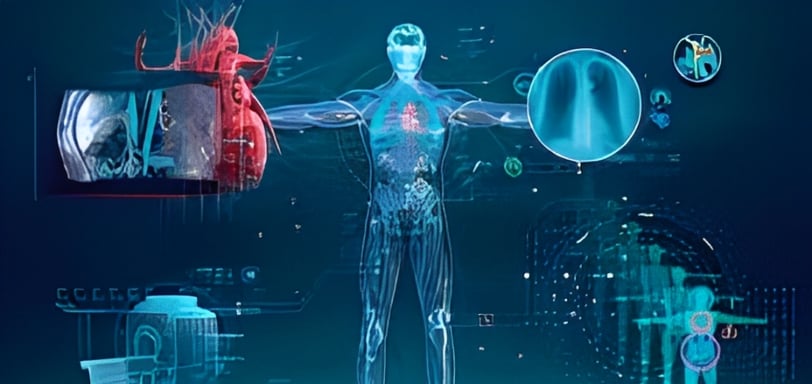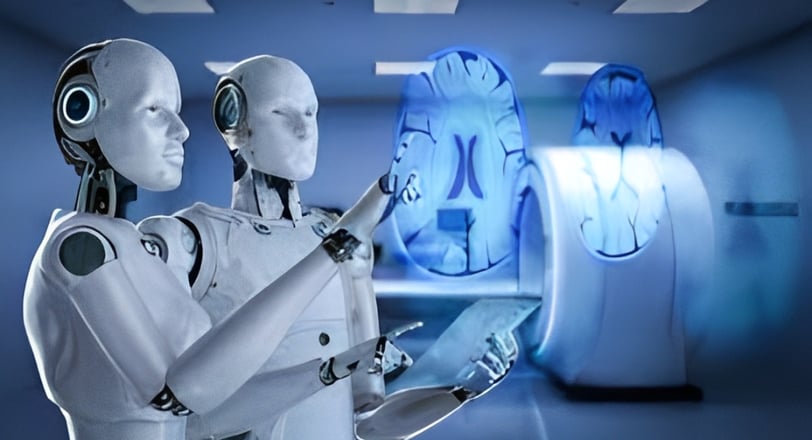The Role of AI in Shaping the Future of Radiology and X-Ray Imaging
Artificial Intelligence (AI) is revolutionizing radiology and medical imaging at an unprecedented pace. From early disease detection to workflow automation, AI is not just enhancing diagnostic accuracy—it’s reshaping the future of healthcare. This blog delves into how AI is transforming radiology with a focus on X-ray imaging, and what the future holds for this groundbreaking technology.
2/5/20253 min read


1. AI in Radiology: A New Era Begins
Radiology has always relied on technological advancements, and AI is the latest breakthrough. Machine learning algorithms are trained to analyze complex X-ray images, helping radiologists detect patterns that might be missed by the human eye.
Key AI Innovations in Radiology:
Predictive Diagnostics: AI predicts the likelihood of diseases based on historical data.
Automated Reporting: Saves time by generating preliminary reports for radiologists.
Image Classification: AI classifies images for specific conditions (e.g., lung nodules, fractures).
2. How AI is Benefiting Radiologists and Patients
For Radiologists:
Reduced Workload: AI handles routine tasks, allowing radiologists to focus on complex cases.
Faster Turnaround Times: AI accelerates image analysis, reducing patient wait times.
For Patients:
Better Outcomes: Early detection of diseases means timely treatment and improved recovery rates.
Safer Imaging Protocols: AI ensures optimized radiation exposure for safer diagnostics.
3. Real-World Applications of AI in X-Ray Imaging
Chest X-Rays:
AI can identify pneumonia, tuberculosis, and COVID-19 signs early.
Bone Fracture Detection:
Faster, more accurate detection in emergency care.
Cancer Screening:
AI helps detect breast cancer and lung cancer at earlier stages.
Industrial X-Ray Analysis:
AI detects structural defects in materials and ensures quality control in manufacturing.
4. AI Trends to Watch in Radiology
Deep Learning Algorithms: More advanced AI models for better accuracy.
AI-Powered Portable Devices: Making diagnostics accessible in rural and remote areas.
Integration with 5G Networks: Faster data transfer for real-time diagnostics.
5. AI-Powered Portable X-Ray Machines: Revolutionizing Point-of-Care Diagnosis
Portable X-ray machines have already brought diagnostics to remote and underserved regions. However, when paired with AI, they offer even more remarkable possibilities.
Key Advantages:
Instant Diagnosis: AI algorithms analyze images on the spot, providing real-time results.
Emergency Applications: In disaster zones or accidents, portable AI-powered X-ray machines enable quick assessments without the need for specialized radiologists.
Reduced Diagnostic Errors: By offering a second opinion, AI ensures more reliable results, even in challenging environments.
Example Use Case:
A rural healthcare center with limited resources can utilize an AI-enhanced portable X-ray device to detect tuberculosis or pneumonia, significantly improving patient outcomes.
6. AI in Veterinary Radiology: Enhancing Animal Healthcare
AI’s potential extends beyond human healthcare to veterinary services. Diagnosing fractures, internal injuries, and respiratory diseases in animals is now easier and more accurate.
Why AI in Veterinary Radiology Matters:
Early Detection of Illness: AI identifies subtle abnormalities that may go unnoticed.
Faster Treatment Plans: With instant analysis, vets can make quicker decisions and provide timely treatment.
Improved Pet Wellness: Routine AI-based scans help detect chronic conditions early, improving the quality of life for pets.
7. Industrial X-Ray with AI: Quality Control Redefined
AI is not limited to medical imaging. In industries like manufacturing, AI-driven X-ray systems are critical for ensuring the structural integrity of products.
Applications in Industry:
Aerospace: Detecting cracks or weaknesses in aircraft components.
Automotive: Ensuring the quality of car parts to avoid failures.
Construction: Identifying flaws in building materials to enhance safety standards.
With AI, companies can save significant costs by reducing production errors and improving quality control measures.
8. Future Prospects: What’s Next for AI and X-Ray Technology?
The future of AI in radiology looks promising. New advancements in deep learning, 3D image reconstruction, and predictive analytics are already under development. In the coming years, we can expect:
AI Integration with Robotics: Automated X-ray machines for continuous scanning in hospitals and manufacturing units.
Wearable X-Ray Devices: Portable X-ray gadgets with AI for on-the-go diagnostics.
AI-Driven Preventive Healthcare: Predictive analysis for early disease prevention using historical data and current imaging.


Reference Website Link:
Fujifilm's AI-Powered Chest X-Ray Analysis
AI in Tuberculosis Screening in India
AI Enhancing Chest X-Ray Diagnoses in South Australia
NHS England's Adoption of AI for Bone Fracture Detection
Behold.ai's AI Detects Early Lung Cancer
